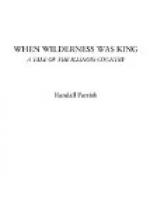At the time of our arrival the protective armament of this primitive Fort, besides the small-arms of the garrison, consisted of three pieces of light artillery, brass six-pounders of antique pattern, relics of the Revolution. Outside the Fort enclosure, only a few yards to the west along the river bank, stood the agency building, or, as it was often termed, “goods factory,” built for purposes of trading with the Indians, so that it would not be necessary to open the Fort to them. This agency building was a rather large two-story log house, not erected for any purposes of defence. Along the southern side of the stream, in both directions, the soldiers had excavated numerous root-houses, or cellars, in which to store the products of their summer gardens,—these excavations fairly honeycombing the bank.
Such was Fort Dearborn in August of the fatal year 1812. It stood ugly, rude, isolated, afar from any help in time of need. Its nearest military neighbor lay directly across the waters of the Great Lake, where a small detachment of troops, scarcely less isolated than itself, garrisoned a similar stockade near the mouth of the river Saint Joseph. To the westward, the vast plains, as yet scarce pressed by the adventurous feet of white explorers, faded away into a mysterious unknown country, roamed over by countless tribes of savages; to the northward lay an unbroken wilderness for hundreds of leagues, save for a few scattered traders at Green Bay, until the military outpost at Mackinac was reached; to the eastward rolled the waters of the Great Lake, storm-swept and unvexed by keel of ship, an almost unsurpassable barrier, along whose shore adventurous voyagers crept in log and bark canoes; while to the southward alternating prairie and timber-land stretched away for unnumbered leagues the Indian hunting-grounds,—broken only by a few scattered settlements of French half-breeds.
From the walls of the Fort the eye ranged over a dull and monotonous landscape, nowhere broken by signs of advancing civilization or even of human presence. A few hundred yards to the east the waves of Lake Michigan broke upon the wide, sandy beach, whence the tossing waters stretched away in tumultuous loneliness to their blending with the distant sky. Southward, along the shore of the lake, the nearly level plain, brown and sun-parched, soon merged into rounded heaps of wind-drifted sand, barely diversified by a few straggling groups of cottonwoods. To the westward extended the boundless prairie, flat and bare as a floor, except where the southern fork of the little river cut its way through the soft loam, and gave rise to a scrubby growth of cottonwood and willow; while northward, across the main body of the river, the land appeared more rugged and broken, and somewhat heavily wooded with oak and other forest trees, but equally devoid of evidences of habitation.




